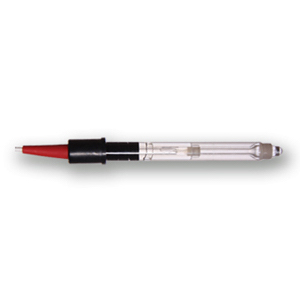Redox Electrode Range
A Redox Electrode is designed to measure the oxidation or reduction potential of the solution in which the redox electrode is immersed. We break down our various types of Redox Electrode into the following categories:-
Redox Sensor
We use this term to broadly cover a sensor which is designed to measure the Redox value of a solution. When we use this term we refer to both our glass bodied Redox Electrodes and industrial housed Redox Probes.
Redox Probe
Redox probe refers to our industrial housed Redox sensors — if you're looking for either a submersion or inline type of Redox sensor then please visit the Redox probe section.
Redox Electrode
A Redox Electrode is a term we reserve for a glass boded Redox sensor which are sometimes referred to as laboratory Redox electodes and are often used in light industrial, water treatment, wet-leisure (spa and swimming pool), hydroponics, laboratory and educational applications.
Redox Electrode Principal of Operation
A Redox electrode will measure the ratio of oxidised species to reduced species in a solution where both are present. The indicitor electrode will measure the electron movement and to do this, it must be chemically inert and an excellent electron conductor. In our redox electrodes we often use a platinum band to fulfil this function as it excels at both functions.
The reference electrode of our combination redox electrode range are manufactured using silver silver chloride within a salt bridge polymer. Based on the oxidising or reducing reaction taking place a miliivolt potential is generated which has a working range of from ±2000mV.
This mV potential is then amplified within a redox instrument for measurement or control purposes.
Redox Electrode Temperature Effects
The same characteristics of of a slope factor and temperature dependent zero apply with Redox measurement as they do with pH measurement. Temperature compensation is not normally applied, this is mainly because Redox Potential measurements are normally made to follow Redox reactions rather than for their own purpose.
The competition of a Redox reaction will normally result in a significant change in the Redox millivolts trading, and this change is normally much larger than the errors introduced by temperature variation.
Redox Electrode Poisoning and Redox Calibration
Redox Electrodes can become slow or sluggish in responding to a change in the Redox potential with age or if the platinum band becomes compromised. This is normally if the surface becomes scratched or if a precipitate (such as oil or grease) forms on the surface. Alternatively if a molecular oxide forms on the surface of the platinum this can also slow the response or result in incorrect readings.
Gently cleaning the surface of the Redox electrode should remedy a slow or sluggish response from a compromised reference material.
Occasionally a Redox electrode may be poisoned by the absorption of organic contaminants, which can occur at very low pH levels (although not exclusively) or in very aggressive oxidising conditions.
To test the performance of a Redox electrode we recommend the use of a Redox Calibration Solution - where the electrode is immersed in a solution with a known and stable Redox value. Then by calibrating the measuring instrument to the known Redox standard immersing the solution in a second Redox standard will indicate both the time taken to 'swing' from one value to the next as well as the difference between measured value of the second solution compared to the second solutions known value.
A poisoned Redox electrode will often show a reading different to the Redox value of the Redox buffer standard, but the difference between the measured values is approximately equal to the difference between the two Redox buffer standards.
Redox Electrode Range
9016-10B
Redox Electrode model 9016-10B has a platinum band, epoxy body and is supplied with 3 metres feet of connecting cable and a BNC Process connector.
As the 9016-10B is a low cost redox electrode which is excellent for wet leisure applications such as spa and swimming pools, hydroponics applications, water treatment, laboratory usage and for light industrial environments.
Suitable for use at temperatures from 0 - 50ºC
9065-10B
Glass bodied Redox electrode model 9065-10B with platinum band and 3 metres of connecting cable with BNC process connector.
The 9065-10B Redox electrode has a ryton flared cap for use with inline redox sensor holders and offers precision redox measurement.
Designed for laboratory or light industrial use where precision Redox measurement is critical.
Operating temperature of 0 - 60ºC
9086-10B
Double junction redox electrode model 9086-10B with glass body has a double junction for resistance to Redox electrode poisoning.
The Double Junction reference electrode has a high temperature polymer reference for use with temperatures up to 100ºC and is fitted with 3 metres of connecting cable and a BNC process connector.
The platinum band and annular ceramic reference offer precision Redox measurements, excellent response time and resistance to electrode poising in environments that would effect less durable Redox electrodes.
9386-10B
Replacement Redox Electrode model 9386-10B is designed for use with our lock-n-load self isolating inline redox sensor holder assembly
The 9386-10B is a double junction Redox electrode designed to be resistant to electrode poisoning and thanks to its high temperature polymer can be used in temperatures up to 100ºC.
As standard this Redox electrode has 3 metres of connecting cable and a BNC process connector and a platinum band for Redox measurement.
Where the stainless steel lock-n-load has been used, the 9386-10B is also available with an optional 316 stainless steel sheath






